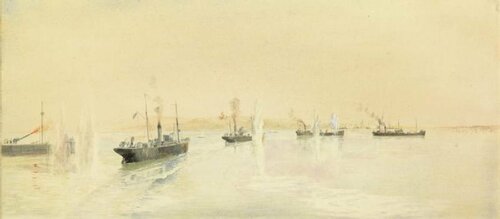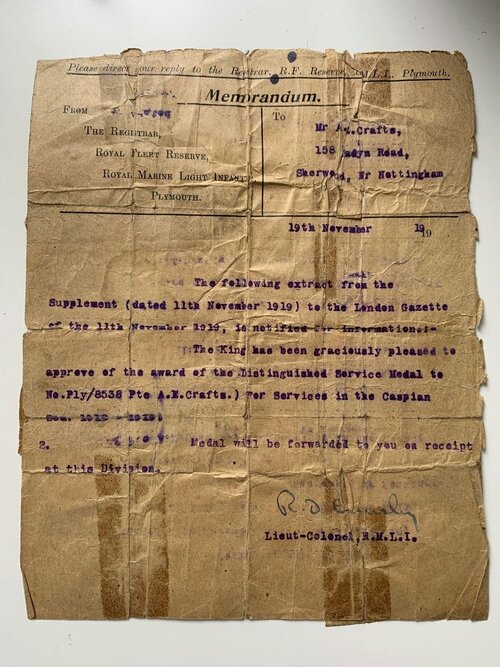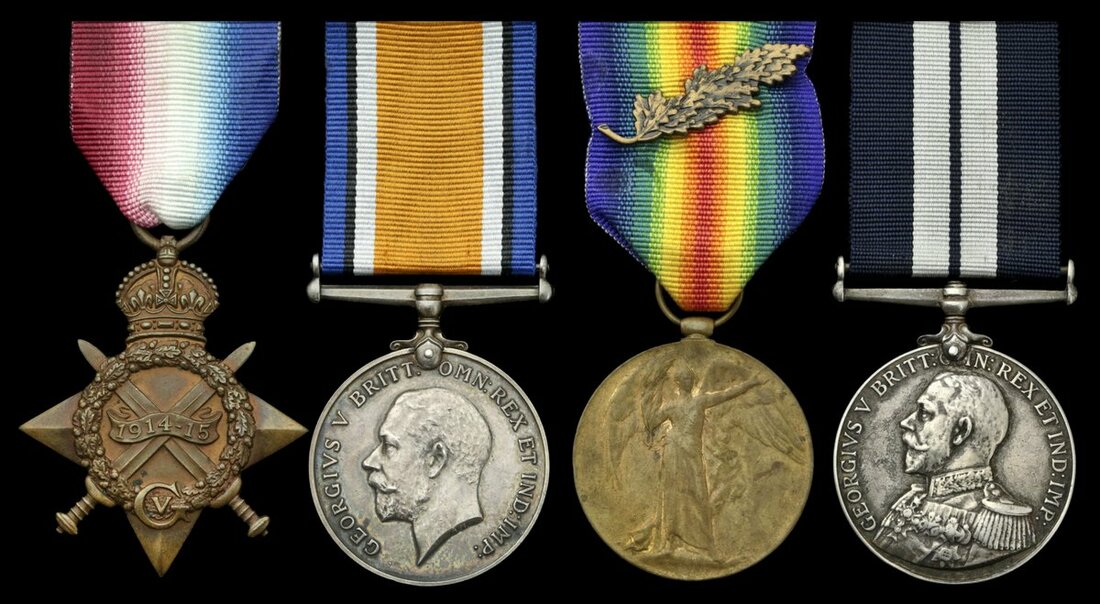Auction: 21002 - Orders, Decorations and Medals
Lot: 215
(x) A scarce 'Caspian Sea 1918-19' D.S.M. group of four awarded to Private A. E. Crafts, Royal Marines Light Infantry, decorated for his gallantry on the Raid on Fort Alexandrovsky on 21 May 1919
Distinguished Conduct Medal, G.V.R. (Ply/8538. Pte. A. E. Crafts. R.M.L.I. Caspian Sea. 1918-1919.'); 1914-15 Star (Ply. 8538, Pte. A. E. Crafts. R.M.L.I.); British War and Victory Medals, M.I.D. oak leaves (Ply.8538 Pte. A. E. Crafts. R.M.L.I.), very fine (4)
D.S.M. London Gazette 11 November 1919.
Albert Ernest Crafts was born at Hucknall, Nottinghamshire on 5 June 1879 and first joined the Royal Marines on 20 April 1897. Having served in China in 1900 (Medal) and thence left the service. Re-enlisted on 5 June 1909, he saw further active service during the Great War. Crafts distinguished himself during the operations in the Caspian Sea aboard Emile Nobel, especially distinguishing himself during the attack on Fort Alexandrovsk on 21 May 1919. Besides earning the D.S.M., he also added a 'mention' for the campaign (London Gazette 9 October 1919, refers).
The attack on the Soviet base at Fort Alexandrovsk came to a head on May 21. The British, with 5 auxiliary cruisers 1 seaplane carrier under Commodore (late Admiral) Norris, came up against a Soviet force of 1 auxiliary cruiser, 1 destroyer, 1 minelayer, 1 floating battery and 2 submarines. The flotilla approached, the Soviets quickly lost the patrol boat Schastlivyy due to grounding while attempting to distract the British. Once the main battle erupted, the Soviets initially appeared victorious: a direct hit was scored on the bridge of Kruger (but with little damage), while two direct hits caused more harm to the Emile Nobel, which suffered 5 killed and 7 wounded. The first phase of the battle resulted in a temporary British retreat and Emile Nobel - with Crafts on board, being forced to withdraw. Other British sources state casualties were 5 killed and 3 wounded, in addition to 3 White Russians killed and 2 wounded: none of the ships suffered serious damage.
Shortly after, Commodore Norris engaged the Soviets once more, focusing the superior firepower of his ships: this time results were different when Kruger shelled and sunk the floating battery. The destroyer Moskvityanin was quickly lost due to grounding after multiple failures on guns and engines. The depot-ship Revel was full of oil and a large explosion was triggered after she was hit, mortally damaging the minelayer Demosthenes (later scuttled). The explosion also engulfed the mine-carrier Tuman, the auxiliary ship Gelma, Zoroaster (not to be confused with the British ship) and a number of small barges. The small submarine Minoga was also damaged by fire. Meanwhile the Soviet flagship, the auxiliary cruiser Caspian, was damaged by two direct hits.
Commodore Norris halted fire, having caused serious losses to the enemy and after having spent most of the ammunition. During the battle, the Soviet submarine Makrel attempted to move into an attack position but failed.
Discharged to the Royal Fleet Reserve on 19 October 1920, Crafts went to live at Sherwood, North Nottingham; sold together with original Memorandum confirming the D.S.M., Demob certificate, Certificate of Discharge and Service Record from 26 November 1917 until his discharge.
Subject to 5% tax on Hammer Price in addition to 20% VAT on Buyer’s Premium.
Sold for
£1,900
Starting price
£480











